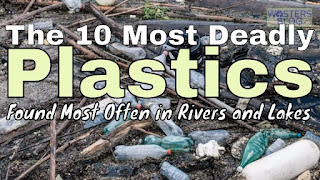The 10 Most Deadly Plastics Found Most Often in Rivers and Lakes
The 10 worst plastic pollutants in rivers and lakes ranked by prevalence are:1 - Plastic bottles and lids.2 - Food wrappers (crisp packets and sweet wrappers).3 - Cigarette butts4 - Sanitary items (nappies, sanitary towels, tampons and wet wipes).5 - Plastic or polystyrene takeaway containers.6 - Cotton bud sticks7 - Plastic or polystyrene cups.8 - Smoking-related packaging.9 - Plastic straws, stirrers and cutlery.10 - Plastic bags.
The Plastic Rivers report, published today (8 April 2019) in association with Plastic Oceans UK, has analysed data from nine studies of freshwater sources across the UK and Europe, revealing the worst ten plastic pollutants in the UK’s rivers and lakes.
It ranked types of macroplastic by prevalence, focusing on consumer items and excluding items relating to fishing, agriculture and industry.
Plastic bottles are the biggest contributor to freshwater plastic pollution, followed by food wrappers and cigarette butts, the research found.
Much of the plastics focus to date has been on the shocking impact pollution is having on ocean species, but up to 80% of the plastic in our seas actually comes from rivers. Understanding the situation in freshwater environments is an essential but often overlooked factor in stemming the tide of plastic reaching our oceans.
The Plastic Rivers report shows that the products we buy every day are contributing to the problem of ocean plastic. Our discarded plastic enters rivers from litter generated by our on-the-go lifestyle and items we flush down our toilets. This throw-away approach is having much more serious consequences much more serious consequences than previously imagined, and the report shows really simple ways to avoid this problem and stop plastic pollution.
Source: CIWM Journal
Click the link above to see the full article, or go to CIWM Online and search "plastic pollution".
Worldwide reliance on disposable plastic packaging is overwhelming our planet.
By 2050, the oceans will contain more plastic than fish by weight.
Plastic pollution is toxic to human health.
Even babies are born pre-polluted.
Plastic pollution and climate change are parallel global emergencies.
Plastic is a petroleum product; to truly divest from fossil fuels, we must reduce our collective plastic footprint. via www.plasticpollutioncoalition.org
Why is Plastic Litter and Pollution Growing So Fast?
The world population is living, working, vacationing, increasingly conglomerating along the coasts, and standing on the front row of the greatest, most unprecedented, plastic waste tide ever faced.Washed out on our coasts in obvious and clearly visible form, the plastic pollution spectacle blatantly unveiling on our beaches is only the prelude of the greater story that unfolded further away in the world’s oceans, yet mostly originating from where we stand: the land.
For more than 50 years, global production and consumption of plastics have continued to rise. An estimated 299 million tons of plastics were produced in 2013, representing a 4 percent increase over 2012, and confirming and upward trend over the past years.
(See: Worldwatch Institute – January 2015). In 2008, our global plastic consumption worldwide has been estimated at 260 million tons, and, according to a 2012 report by Global Industry Analysts, plastic consumption is to reach 297.5 million tons by the end of 2015. via plastic-pollution.org
Is More Recycling the Solution?
Not really. Recycling does not really address plastic pollution, since recycled plastic is "properly" disposed of. Whereas, plastic pollution comes from improper disposal.Since the ocean is downstream from nearly every terrestrial location, it is the receiving body for much of the plastic waste generated on land. Several million tonnes of debris end up in the world's oceans every year, and much of it is improperly discarded plastic litter.
The first oceanographic study to examine the amount of near-surface plastic debris in the world's oceans was published in 2014. It estimated that at least 5.25 trillion individual plastic particles weighing roughly 244,000 tonnes (269,000 tons) were floating on or near the surface.
A Seriously Damaging Effect at the Bottom of the Food Chain
Because it comes in sizes large and small, polluting plastics even affect the world's tiniest organisms such as plankton.When these organisms become poisoned due to plastic ingestion, this causes problems for the larger animals that depend on them for food. This can cause a whole slew of problems, each step further along the food chain. Plus, it means that plastic are present in the fish that many people eat everyday.
Most of the litter and pollution affecting the world's oceans derives from plastics. This is having had terrible consequences on many marine species, which can lead to consequences for those that eat fish and marine life for nutrients – including people. via www.conserve-energy-future.com
Sources of Ocean Plastic - Mismanaged Waste and Inadequately Disposed Waste
Mismanaged waste is material which is at high risk of entering the ocean via wind or tidal transport, or carried to coastlines from inland waterways.Mismanaged waste is the sum of material which is either littered or inadequately disposed.
Inadequately disposed and littered waste are different, and are defined in the sections below.
Inadequately disposed waste is that which has the intention of being managed through waste collection or storage sites, but is ultimately not formally or sufficiently managed.
This includes disposal in dumps or open, uncontrolled landfills; this means the material is not fully contained and can be lost to the surrounding environment.
This makes it at risk of leakage and transport to the natural environment and oceans via waterways, winds and tides. via ourworldindata.org

